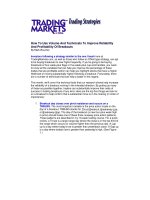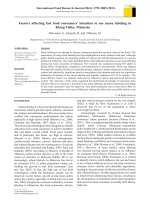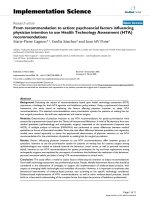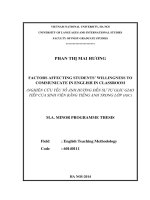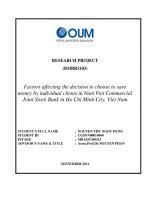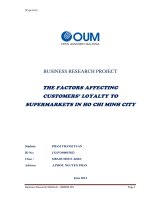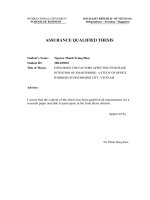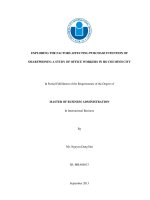Factors affecting customers intention to use sredit card
Bạn đang xem bản rút gọn của tài liệu. Xem và tải ngay bản đầy đủ của tài liệu tại đây (847.54 KB, 78 trang )
UNIVERSITY OF ECONOMICS – HO CHI MINH CITY
International School of Business
Mai Viet Dung
FACTORS AFFECTING CUSTOMER’S INTENTION
TO USE CREDIT CARD
Evidence from Vietnam
MASTER OF BUSINESS (Honours)
Ho Chi Minh City – Year 2014
UNIVERSITY OF ECONOMICS – HO CHI MINH CITY
International School of Business
Mai Viet Dung
FACTORS AFFECTING CUSTOMER’S INTENTION
TO USE CREDIT CARD
Evidence from Vietnam
ID: 22120009
MASTER OF BUSINESS (Honours)
SUPERVISOR: Dr. Tran Phuong Thao
Ho Chi Minh City – Year 2014
DEDICATION
To my loving family and friends
who support me a lot in my life, study, and work
ACKNOWLEDGEMENTS
Composing this master thesis is a long journey with many unexpected ups and downs;
thanks to my great family, good friends, colleagues, and resourceful supervisor, I have
accomplished this goal. I am blessed beyond all measures, and I just want to say thank you.
I wish to extend special thanks to my supervisor, Dr. Tran Phuong Thao, for all your
time, advice, comments, and encouragement. I could not have even imagined how I would
have completed this thesis without your support. Also, I would like to thank Dr. Nguyen
Dinh Tho, Dr. Nguyen Thi Mai Trang, and Dr. Dinh Thai Hoang, who all provide me initial
foundation of research design as well as data analysis. To the ISB research committee, I am
thankful for your time, comments, and kind words that helped me through this process.
To my friends at Master of Business program – International School of Business,
thank you for your friendship, your laughter, and all the time we have together. It made the
life of a business post graduate a pleasure.
Finally, to my parents and sister, thank you for teaching me the importance and value
of education. You are the most supportive force of all; I am grateful to you for your constant
support, love, encouragement, faith, and belief in me.
ABSTRACT
Vietnam’s credit card payment market has become one of the most rapidly growing
markets in emerging world; however, there is a paucity of studies about behavioral intention
in the context of credit card and especially in Vietnam. The Theory of Reasoned Action
(TRA) was used as the foundational model in order to develop a modified model reflecting
intention to use credit card in the thesis. Specifically, the relationships among six factors –
attitude towards using credit card, perceived financial cost, social influence, perceived
credibility, information about credit card, and materialism – and customer’s intention to use
credit card were examined. Results suggest that attitude towards using credit card, social
influence, and information about credit card are important determinants to predict
Vietnamese bank customer’s intention to use credit card.
Key words: credit card, intention to use, TRA, Vietnam.
TABLE OF CONTENT
ACKNOWLEDGEMENTS
ABSTRACT
LIST OF FIGURES
LIST OF TABLES
ABBREVIATIONS
CHAPTER 1 - INTRODUCTION
1
1.1. Background of study
1
1.2. Research problem
3
1.3. Research objective and research questions
5
1.4. Scope of research
5
1.5. Research significance
6
1.6. Structure of the thesis
6
CHAPTER 2 - LITERATURE REVIEW, HYPOTHESES
AND CONCEPTUAL MODEL
8
2.1. Foundational theories
8
2.1.1. Theory of Reasoned Action (TRA)
8
2.1.2. Theory of Planned Behavior (TPB)
9
2.2. Customer’s intention to use credit card
10
2.3. Attitude and customer’s intention to use credit card
12
2.4. Perceived financial cost and customer’s intention to use credit card
13
2.5. Social influence and customer’s intention to use credit card
14
2.6. Perceived credibility and customer’s intention to use credit card
15
2.7. Information about credit card and customer’s intention to use credit card
16
2.8. Materialism and customer’s intention to use credit card
17
2.9. Conceptual model
18
2.10. Chapter summary
19
CHAPTER 3 – RESEARCH METHODOLOGY
21
3.1. Research process
21
3.2. Measurement
22
3.2.1. Measurement scale
22
3.2.2. Pilot test
25
3.3. Sampling and Data collection
26
3.3.1. Minimum sample size
26
3.3.2. Data collection
26
3.4. Data analysis
27
3.4.1. Reliability measure
27
3.4.2. Exploratory factor analysis (EFA)
28
3.4.3. Multiple regression analysis
28
3.5. Chapter summary
CHAPTER 4 – DATA ANALYSIS AND RESULTS
29
30
4.1. Profile of respondents
30
4.2. Assessment measurement scale
32
4.2.1. Reliability scores
32
4.2.2. Exploratory factor analysis (EFA)
34
4.3. Correlation
38
4.4. Hypothesis testing by multiple regression
39
4.4.1. Checking assumptions of multiple regression
39
4.4.2. Testing hypotheses of conceptual model
40
4.5. Chapter summary
CHAPTER 5 – CONCLUSION, IMPLICATIONS, AND FURTHER STUDIES
43
44
5.1. Key findings and discussion
44
5.2. Implications
47
5.2.1. Theoretical implications
47
5.2.2. Managerial implications
48
5.3. Limitations and suggestions for future research
REFERENCES
50
52
APPENDICES
Appendix A: Questionnaire (English - Vietnamese version)
Appendix B: KMO and Bartlett’s Test
Appendix C: Testing multiple regression assumptions
LIST OF FIGURES
Page
Figure 2.1: The Theory of Reasoned Action ........................................................................ 9
Figure 2.2: The Theory of Planned Behavior ..................................................................... 10
Figure 2.3: Conceptual Model............................................................................................ 19
Figure 3.1: Research process ............................................................................................. 22
LIST OF TABLES
Page
Table 3.1: Scale Items ........................................................................................................ 24
Table 4.1: Profile of respondents ........................................................................................ 30
Table 4.2: Total Cronbach’s alpha...................................................................................... 32
Table 4.3: Cronbach’s alpha, SCR, AVE for each variable................................................. 32
Table 4.4: Total variance explained .................................................................................... 35
Table 4.5: Rotated Component Matrix ............................................................................... 36
Table 4.6: Summarized Factor analysis .............................................................................. 37
Table 4.7: Bivariate Correlation ......................................................................................... 38
Table 4.8: Regression Analysis Model ............................................................................... 40
Table 4.9: Hypotheses results............................................................................................. 42
ABBREVIATIONS
ATM:
Automated teller machine
ATT:
Attitude towards using credit card
AVE:
Average variance extracted
EDC:
Electronic data capture
EFA:
Exploratory factor analysis
FAQ:
Frequently asked questions
INF:
Information about credit card
INT:
Customer’s intention to use credit card
KMO:
Kaiser-Meyor-Olkin
MAT:
Materialism
PC:
Perceived credibility
PFC:
Perceived financial cost
POS:
Point-of-sale
SCR:
Scale composite reliability
SI:
Social influence
SPSS:
Statistical package for social sciences
TAM:
Technology acceptance model
TPB:
Theory of planned behavior
TRA:
Theory of reasoned action
VIF:
Variance inflation factors
VND:
Vietnam Dong
1
CHAPTER 1 - INTRODUCTION
1.1. Background of study
Payment represents both cash and non-cash financial transactions. In cash payment,
cash moves directly from the buyers’ bank to the sellers’ bank through face-to-face
exchange in the market; whereas, in non-cash payment, payment information flows from the
buyer to the seller through commercial banks (Sumanjeet, 2009). Non-cash payment can be
made by means of credit transfers, cheques, cards, direct debits, e-money, mobile payment
(Andries & Martin, 2004; Dimov, 2011; Capgemini, 2014).
Non-cash payment method brings benefits not only for banks but also for customers
and merchants. Going cashless cuts the security cost and cash handling cost dramatically
(Coyle-Camp, 1994). It also makes the economy more efficient and yields a meaningful
boost to the economic growth through a multitude of factors including transaction
efficiencies, consumers’ access to credit and their confidence in the payment system
(Proquest, 2013). Thus, this type of payment has been developed so far. As indicated by
Capgemini (2014), total global non-cash volume is expected to reach 365.6 billion
transactions during the year 2013; in which, card payment is the primary driver of non-cash
transactions growth. Among card payment method, two major types of card are debit card
and credit card issued by commercial banks. They are issued under an umbrella brand by
financial institutions that are members of a bankcard association, i.e. Visa, Mastercard, or
by individual institutions (Foscht, Maloles, Swoboda, & Chia, 2010). Borzekowski and
Kiser (2007) indicated that debit cards appear to serve primarily as a substitute for cash and
cheques; credit cards are very often used to extend payment.
Debit cards allow the cardholder to receive cash and monitor account activity at an
automated teller machine (ATM), as well as pay for goods and services. A debit card
transaction involves the automatic withdrawal of funds from the cardholder’s demand
deposit bank account. It means that the customer must have the funds in his/her account
before a purchase transaction is consummated, and he/she cannot spend more than the
money in his/her account (Foscht et al., 2010).
2
Credit card was first issued in USA by the Western Union in 1914, then it has been the
most popular and advanced means of payment and settlement (Bai & Chen, 2013; Kaynak,
Kucukemiroglu, & Ozmen, 1995). Credit card payment is the preferred payment method to
purchase goods and services abroad due to factors such as convenience, security, and costs,
accounting for 74% of all non-cash payments transactions worldwide (Capgemini, 2014). It
is referred as the mean of payment that involves the concept of buying first and paying later
(Amin, 2012a). It allows for purchases against a pre-approved line of credit; the account
holder has the choice of whether to pay off the entire balance without interest or opt for
monthly installments with the balance serving as revolving credit with interest (Euromonitor
International, 2010; Foscht et al., 2010). Furthermore, it is also easier to obtain credit card
than applying for personal loan, which requires the applicant to comply with more
formalities like providing guarantors or collaterals (Ahmed, Ismail, Sadiq Sohail, Tabsh, &
Alias, 2010). In other words, credit card is a credit certificate issued by banks and non-bank
financial institutions to users so as to be used both as a convenient payment medium in
place of cash and cheques and as a means of obtaining short-term revolving credit (AbdulMuhmin & Umar, 2007; Bai & Chen, 2013).
In the literature, scholars are interested in doing research on credit card, especially its
pattern usage and customer’s intention to use credit card (e.g. Abdul-Muhmin & Umar,
2007; Ahmed et al., 2010; Amin, 2007, 2012a, 2012b; Chan, 1997; Delener & Katzenstein,
1994; Erdem, 2008; Gan, 2008; Jamshidi, 2012; Johnson, 2007; Khare, Khare, & Singh,
2012). Various studies have examined the adoption of credit cards payment and other noncash payments like internet banking and mobile banking based on foundational theories of
behavioral psychology such as Theory of Reasoned Action (TRA), Theory of Planned
Behavior (TPB), and The Technology Acceptance Model (TAM) (e.g. Ahmed et al., 2010;
Al-Smadi, 2012; Amin, 2007, 2008, 2012a, 2012b; Amin & Ramayah, 2010; Chong et al.,
2010; Lin & Nguyen, 2011; Luarn & Lin, 2005; Pikkarainen, Pikkarainen, Karjaluoto, &
Pahnila, 2004). They extend those theories and include additional variables and constructs
to explain custumer’s behavior in specific contexts. Some factors affecting custumer’s
intention to use credit card payment or other non-cash payments are examined such as:
3
attitude towards behavior (Amin, 2012a), subjective norm (Amin, 2012a; Celik, 2011),
perceived usefulness, perceived ease of use (Celik, 2011); perceived risk (Őzkan,
Bindusara, & Hackney, 2010; Thakur & Srivastava, 2014); security, trust, perceived
advantage (Őzkan, Bindusara, & Hackney, 2010); perceived credibility, the amount of
information about card, perceived expressiveness (Amin, 2007, 2008); perceived financial
cost (Amin, 2012a); adoption readiness, personal innovativeness (Thakur & Srivastava,
2014); bank’s policies (Teoh, Chong, & Yong, 2013); lifestyle (Khare, Khare, & Singh,
2012); materialism (Pinto et al., as cited in Limbu, Huhmann, & Xu, 2012; Norvilitis et al.,
as cited in Limbu et al., 2012; Nga, Yong, & Sellappan, 2011); personal characteristics
(Foscht et al., 2010; Khare et al., 2012); demographics (Khare et al., 2012; Teoh et al.,
2013); etc.
1.2. Research problem
Owing to the utilities of credit card payment as well as economic and customer
behavioral changes, credit card payment has been grown quickly for decades. The most
significant changes are occurring in emerging world, driven by rapid urbanization, a
growing middle class as well as younger population (Rau, 2013). However, most of
academic researches on credit card are about actual behavior in developed and western
countries, some are from Asia countries; there is a paucity of studies about behavioral
intention in the context of credit card and especially in Vietnamese market. Due to legal,
structural, cultural, geographical, and socio-economic differences among countries,
variances in practices may have an effect on credit card behavioral intention.
Vietnam is a developing country, and its card payment market has become one of the
most rapidly growing markets in the world, increasing at an annual rate of 37% between
2008 and 2012 (Rau, 2013). To date, the Vietnam’s card payment network has accepted
most popular card brands in the world, including Visa, MasterCard, American Express,
JCB, Diners Club, CUP and DiscoverCard. This is partly supported by the Vietnamese
government project titled Development of Non-cash Payment in Vietnam, Period 20062010 with vision 2020 or Project 291, approved by the Prime Minister in December 2006.
The document emphasises the promotion of non-cash payment for the replacement of cash,
4
ensuring the safety, convenience and efficiency of payment systems and non-cash payment
instruments; striving to reduce the ratio of cash to total payment instruments to around 15%
by 2020 (Le & Lim, 2008).
Credit card has been introduced in Vietnam since 1996, but credit card usage still deals
with limitations. In many economically developed countries, credit card ownership is so
widespread among customers that penetration rates are approaching 100 percent (AbdulMuhmin & Umar, 2007); however, there are only 2.43 million credit cards issued in
Vietnam (State Bank of Vietnam, 2014b) while the population of Vietnam is expected to
reach 90 million at the end of the year 2013 (Tuoitrenews, 2012). This means one credit
card per 37 persons, whereas the corresponding figure for Europe is one for 10 persons, and
for the USA is one credit card for every 4 persons (Kaynak & Harcar, 2001). Additionally,
the number of credit cards is too small in comparison to the total of 46,762,997 personal
bank accounts (State Bank of Vietnam, 2014c). Therefore, Vietnam has a huge potential for
credit cards expansion.
Moreover, cash payment is still “king” in Vietnam while credit cards have become a
major system for payment in many developing countries of the world (Watkins, 2000). The
reason is that payment by cash is the most “transparent” form of payment with consumers
having a good awareness of the real value of funds being used (Raghubir & Srivastava, as
cited in Kamleitner & Erki, 2013). Many consumers who possess bank cards still prefer to
use cash in purchase due to the Vietnamese cash-oriented payment culture. A number of
consumers are unaccustomed to using cards and even unaware that cards could be used to
make purchases (Euromonitor International, 2010). A majority of card transactions are cash
withdrawals (Le & Lim, 2008); card transactions registered retail value growth of only 18%
in 2010 despite the increasing presence of point-of-sale (POS) terminals in many modern
retail outlets (Euromonitor International, 2010). These bring out a paradox between the
growth of credit cards and the card payment use.
Since becoming an official member of World Trade Organization in January 2007
(World Trade Organization, 2007), the Vietnamese government has loosened a number of
protective measures for domestic commerce as well as banking financial fields. There are
5
over 150 banks and credit institutions fairly competing in Vietnam these days (State Bank of
Vietnam, 2014a). Customers no longer just bank with one institution but are increasingly
using a number of banks at the same time and have thus become “multi-banked” (Baumann,
Elliott, & Burton, 2012). Hence, banks are developing banking products and services,
especially modern ones like credit card, so as to struggle for a bigger share in such a
potential market. As a result, customers have a wide range of choices of credit card from
different issuers with specific features. The ultimate success of credit card payment in
Vietnam is still depending on customers’ perception and whether they are willing to use
credit card, as well as how banks understand customer insight in launching their credit cards
and related services. As such, there is a need to examine the factors determining Vietnamese
bank customer’s intention to use credit card.
1.3. Research objective and research questions
The research objective is to investigate critical factors affecting Vietnamese bank
customer’s intention to use credit card. To achieve this goal, it extends the applicability of
the foundational theories about behavioral psychology in a credit card context. More
specifically, based on previous researches and Vietnamese context, six factors are taken into
account, namely: attitude towards using credit card, perceived financial cost, social
influence, perceived credibility, information about credit card, and materialism. The
research questions are as follows:
Question 1: Do attitude towards using credit card, perceived financial cost, social
influence, perceived credibility, information about credit card, and materialism statistically
affect customer’s intention to use credit card?
Question 2: If yes, to what extent how do these factors affect customer’s intention to
use credit card?
1.4. Scope of research
The study is conducted in Ho Chi Minh City which is the largest city and a bustling,
dynamic and industrious center in Vietnam. Most of banking institutions in Vietnam have
established and developed their own products and services in this city.
6
The data collection is based on administered questionnaire towards individual
customer of commercial banks. The questionnaire is designed to capture custormer’s view
on six constructs: attitude towards using credit card, perceived financial cost, social
influence, perceived credibility, information about credit card, and materialism, together
with their intention to use credit card.
The timeframe of conducting was arranged from the middle of July to the end of
August in 2014.
1.5. Research significance
Because consumers now have more options for payment, including cash, cheques,
debit cards, credit cards, they not only make product choice decision, but also choose which
payment mode to use in purchasing process. Factors influencing these payment mode
decisions are of interest to financial institutions, retailers and policy makers (AbdulMuhmin, 2010).
The study is expected to enhance understanding of factors affecting customer’s
intention to use credit card with evidence from Vietnam. This contributes to existing
academic knowledge about customer behavioral psychology, especially in credit card
context. The results of this research assist in increasing credit card research in not only
Vietnam but also emerging economies, and thus promote more debates about this issue.
In terms of empirical values, the study will be useful for credit cards issuers, mainly
banks, to form suitable marketing strategy in competitive banking industry of Vietnam in
order to attract more customers, as well as government policy makers in their effort on
boosting non-cash payments in Vietnam. Thus, it may support, to some extent, for the
development of the banking industry in Vietnam in the future.
1.6. Structure of the thesis
The thesis is structured into five chapters as follows:
Chapter 1 gives out background of credit card payment, problems related to Vietnam’s
credit card market, and research objectives as well.
Chapter 2 discusses the formulation of research model based on extensive review of
the literature.
7
Chapter 3 renders a discussion on research designing, sampling, and measurements of
constructs in research model.
Chapter 4 conveys results of analyzing the collected data, concentrating on testing
hypotheses proposed in Chapter 2.
Chapter 5 provides roundup and discussion on the findings of research as well as
research limitations and propositions for future work.
8
CHAPTER 2 - LITERATURE REVIEW, HYPOTHESES
AND CONCEPTUAL MODEL
This chapter discusses a thorough review of foundational theories and prior studies on
customer’s behavioral intention, proposes hypotheses about the relationship between six
constructs and the customer’s intention to use credit card, and then develops a conceptual
model.
2.1. Foundational theories
Two most powerful tools to test behavioral intention are Theory of Reasoned Action
(TRA) and Theory of Planned Behavior (TPB). They have been applied in researches about
behavioral intention in banking context so far (e.g. Al-Smadi, 2012; Amin, 2007, 2008,
2012a, 2012b; Amin & Ramayah, 2010; Chong et al., 2010; Hansen & Solgaard, 2004;
Kaynak & Harcar, 2001; Teoh et al., 2013).
2.1.1. Theory of Reasoned Action (TRA)
TRA is introduced by Fishbein and Ajzen in 1975 to establish relationships between
beliefs, attitudes, intentions and behaviors (Taib, Ramayah, & Razak, 2008). The theory
suggests that the immediate antecedent of a behavior is the intention to perform the behavior
in question. TRA specifies two conceptually independent determinants of intention, namely:
attitude towards behavior, and subjective norm (Ajzen & Madden, 1986). Attitude towards
behavior is referred to the positive or negative feelings an individual has on a particular
behavior. It is a function of one’s salient belief about performing the behavior and an
evaluation of the outcomes resulting from the behavior. Subjective norm refers to the social
pressure an individual has on whether to complete behavior or not. This is a person’s belief
that the salient referent thinks he/she should or should not perform the behavior (Chang,
1998).
According to TRA, the more favorable attitude towards performing a behavior which a
person is holding, the higher intention he/she will perform it. Additionally, a person who
perceives more social pressure to perform a behavior will highly intend to perform it than a
person with lower one.
9
Behavioral beliefs
and evaluation of
outcomes
Attitude toward
behavior
Behavior
Intention
Normative beliefs
and motivation to
comply
Actual
Behavior
Subjective Norm
Figure 2.1: The Theory of Reasoned Action
(Source: Fishbein & Ajzen, 1975)
TRA model has been applied in different contexts. According to Amin (2012b),
various academic works have employed the TRA model into their studies because of three
reasons. Firstly, the theory is well suited for the purpose of examining and predicting a
particular behavior. Secondly, it has been praised for its flexibility to be applied into
different contexts of research like online stock trading, knowledge sharing, banking, and the
marketing area. Thirdly, the TRA can be used to measure behavioral intention and actual of
a particular situations, systems or even products.
2.1.2. Theory of Planned Behavior (TPB)
The TRA is questioned because it assumes that all human behaviors are volitional and
rational (Chang, 1998). It means that an individual has full control over his/her behavior
though not all behaviors are fully volitional or fully controlled by consumers due to various
factors. Therefore, TPB extends from TRA by incorporating an additional construct, namely
perceived behavior control, to account for situations in which an individual lacks substantial
control over the targeted behavior (Ajzen, 1991). According to TPB, an individual’s
behavior can be explained by his/her behavioral intention, which is jointly influenced by
attitude, subjective norms and perceived behavioral control. In which, besides retaining
attitude and subjective norms of TRA, perceived behavioral control refers to an individual’s
perceptions of the presence or absence of the requisite resources or opportunities necessary
for performing a behavior (Ajzen & Madden, 1986).
10
Attitudes
(Behavioral beliefs x Outcome
evaluation)
Subjective Norms
(Normative beliefs x
Motivation to comply)
Behavioral
Intention
Behavior
Perceived Behavioral
Control (Control beliefs x
Influence of Control beliefs)
Figure 2.2: The Theory of Planned Behavior
(Source: Ajzen, 1991)
2.2. Customer’s intention to use credit card
Behavioral intention is defined as a person’s intention to perform various behaviors
(Fishbein & Ajzen, 1975). The construct originally developed in the TRA is widely used in
subsequent models related to customer’s intention. The TRA suggests that behavioral
intention is a direct predictor of actual behavior. In this context, the construct refers to
customer’s intention to use credit card.
Customers have different motives for holding credit card. Some hold credit card for its
convenience as a payment instrument, while others hold it as a mean of obtaining revolving
credit to finance consumption (Abdul-Muhmin & Umar, 2007). Measuring intention will
give acceptable indication of customer’s behavior. In general, prior studies on credit
intention are mainly about the issue of credit card default, attitude towards debt and the use
of credit card (Amin, 2012b).
Erdem (2008) studied the probability of credit card default and the usage intention in
Turkey, then noted that credit card use positively impacts on personal finance, yet led to the
negative impacts such as divorcing, bankruptcy, committing suicide and killing of family
members. Especially, the number of children, level of education, subjective norm, perceived
behavioral control and attitude towards the behavior are important predictors for the
behavioral intention. This study provides important evidence about the need to control
credit card debt.
11
A study carried out in Turkey by Kaynak and Harcar (2001) to examine consumer’s
attitude and intention towards credit card ownership and usage finds that knowledge
structure, beliefs, likes and dislikes as well as attitude of owner influence its usage. Age is
an influential predictor in determining the ownership of a credit card. Barker and Sekerkaya
(1992) also find that the middle age group is the most likely to hold and use credit cards.
Kinsey (as cited in Delener & Kazenstein, 1994) examines the relative importance of
various household characteristics in determining the number of credit card accounts per
household, then finds that having a positive attitude towards credit is one of the most
important variables determining the probability of having one or more credit card accounts.
Abdul-Muhmin and Umar (2007) examine the effect of demographics and attitude towards
debt on credit card ownership and usage in Saudi Arabia. They find out that females are
more likely to possess credit cards than males, card usage tends to be selective, attitude
towards debt is a significant determinant of card ownership but not to usage behavior. In
addition, Davies and Lea (1995) examine the students’ attitude towards debt in the UK and
find that the income level and the amount of debt are positively correlated. Martell and Fitts
(as cited in Delener & Kazenstein, 1994) claim that married individuals with high income
who maintain a number of different bank accounts are more likely to be bank credit card
users. Khare et al. (2012) also states that credit card ownership is dependent on increase in
income and compulsive buying behavior. Gan, Maysami, and Koh (2008) find that the
number of credit cards is significantly influenced by income and gender as well as
perception about credit card.
Mansor and Che-Mat (2009) investigate the impact of demographic factors on Islamic
credit card usage in Malaysia. The study findings are: income is an influential predictor for
the use of Islamic credit cards among the existing users, individuals who have lower and
middle income tend to use credit cards because of its safety and convenience features.
Kaynak and Harcar (2001), and Kinsey (as cited in Delener & Kazenstein, 1994) observes
that as income increases so does the number of credit card accounts. Khare et al. (2012)
reports that younger people are more likely to use credit card while older people are
comfortable with cash payment, and men are more likely to have credit cards than women.
12
Typically, Amin (2012b) analyses the probability of Islamic credit card usage intention
among Islamic bank customers and finds that financial recommendation, knowledge on
credit card, age, marital status, religion and education level significantly affect the
customer’s credit card usage intention.
This study is to measure behavioral intention to use credit card among Vietnamese
bank customers. Some previous studies applied TRA with sufficient modification in this
context (e.g Amin, 2007, 2008, 2012a). Thus, in order to better explain the intention to use
credit card, this study modifies the original TRA model by including the behavioral
intention, attitude and subjective norm, and adding some variables relevant to the
Vietnamese credit card context. Based on prior researches, four variables are considered as
followed: perceived financial cost (e.g Amin, 2012b; Luarn & Lin, 2005), perceived
credibility (e.g Wang, Wang, Lin, & Tang, 2003; Luarn & Lin, 2005; Amin, 2007, 2008),
information about credit card (e.g Pikkarainen et al., 2004; Sharpe et al., 2012), and
materialism (Limbu et al., 2012). All three original variables are renamed so as to fit the
study context: behavioral intention is changed to customer’s intention to use credit card,
attitude is changed to attitude towards using credit card, and subjective norm is change to
social influence.
2.3. Attitude and customer’s intention to use credit card
Attitude is defined as evaluative effect of individuals’ positive or negative feelings in a
particular behavior performing (Fishbein & Ajzen, 1975). In other words, attitude is a
subjective tendency to do something, expressed through the favorable or unfavorable
evaluation of a given object (Eagly & Chaiken, 1993).
Attitude has been an important indicator that shape adoption intention of the system in
different contexts (Jamshidi & Hussin, 2012). Typically, attitude has been modified in
banking context through studies of Taib, Ramayah, and Razak (2008); Amin, Rahman, and
Ramayah (2009); Amin, Rahman, Sondoh, and Hwa (2011). Taib et al. (2008) point out the
significant positive link between attitude and Islamic partnership home financing among
postgraduate students in Malaysia. Also, there is empirical evidence to suggest that attitude
is positively related to credit card usage intensity (Abdul-Min & Umar, 2007). Amin et al.
13
(2011) claims attitude as a significant determinant of Islamic personal financing usage
among Malaysian bank customers; especially, Amin (2012b) finds that attitude has strong
influence over the behavioral intention to use Islamic credit card. Meiden (as cited in Chan,
1997) insists that the greatest determinant of whether a cardholder is inactive or active is
attitude. A research by Kaynak and Harcar (2001) verifies the strong relationship between
the ownership and positive attitude towards credit card.
Vietnam is a developing country where credit card has been introduced for about two
decades but not so popularly used. The customer’s attitude towards using credit card has not
been studied much in the country. Based on the foundational theory and prior findings of
researches in other developing countries like Malaysia, Turkey, and Saudi Arabia as
mentioned above, attitude is expected to positively impact on Vietnamese bank customer’s
intention to use credit card.
Hypothesis 1: Attitude towards using credit card has a positive effect on customer’s
intention to use.
2.4. Perceived financial cost and customer’s intention to use credit card
Limited studies have been examined the importance of perceived financial cost.
Ramayah and Mohd-Suki (2006) find that price is not significantly related to the Internet
banking acceptance. Nevertheless, Luarn and Lin (2005); Mathieson, Peacock, and Chin
(2001); and Amin (2012b) find that perceived financial cost is a significant antecedent
affecting behavioral intention in the banking context. Luarn and Lin (2005) identify that
perceived financial cost has a negative effect on behavioral intention to use mobile banking.
Sripalawat, Thongmak, and Ngramyarn (2011) also support that perceived financial cost is a
critical factor influencing consumer to adopt mobile banking. Amin (2012b) points out that
the greater the perceived financial cost, the likelihood that Islamic credit card is selected
will be lower. To handle such debates, it is worth doing further research about the
relationship between perceived financial cost and behavioral intention.
In this study, perceived financial cost refers to interest rate, annual fee, credit limit,
penalty, monthly installment, and type of transaction (Amin, 2012b; Khalid, Butt, Murtazza,
& Khizar, 2013). A survey of Nielson Finance IPG (2011) states that “high fee is applied”
14
and “high interest rate” are two of barriers Vietnamese customers perceive when thinking
about using credit card. Thus, it is expected that the outcomes of prior studies could also be
generalized into the Vietnam’s credit card context.
Hypothesis 2: Perceived financial cost has a negative effect on customer’s intention to
use credit card.
2.5. Social influence and customer’s intention to use credit card
Social influence as used in this study refers to subjective norm or normative pressure.
It is defined as the degree to which an individual perceives how important other people
nearby believe he/she should perform an activity (Thakur & Srivastava, 2014). In other
words, social influence suggests that behavior is instigated by one’s desire to act as how
others act or think one should act (Chen et al., as cited in Taherdoost, Masrom, & Ismail,
2009).
Social influence may come from family members, relatives, friends, classmates and
colleagues, especially in a collective society (Liao & Shi, 2009). Results of previous studies
have been mixed. Chau and Hu (2001) and Lewis et al. (2003) find subjective norm to have
no direct impact on intention to use information technology. In contrast, Venkatesh and
Davis (2000), Teo and Pok (2003) report a significant relationship between subjective norm
and behavioral intention. Taib et al. (2008) also find social influence to be valid constructs
in explaining an individual’s acceptance of Islamic financing products. Amin et al. (2011)
point out that the clients’ social influence is a significant antecedent of the intention to use
Islamic personal financing. Specifically, a study of Amin (2012a) with the purpose to
explain intention to use the Islamic credit card in Malaysia insists the idea that subjective
norm is significantly positive to customer intention.
In this research, customers using credit card may be perceived by their friends and coworkers as being more up-to-date with purchasing trend, smarter, or more successful. To
some extent, Vietnam is a collective society and Vietnamese customers are easily affected
by crowd psychology. They are likely to sound out relatives, friends, and other surrounding
people so as to gain advice and experience before making a decision. Besides, they tend to
follow the current trends which others do so as not to be isolated. Since credit card is a
